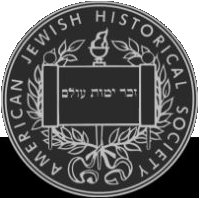American Jewish Army chaplains were among the first to encounter Jewish survivors of the Nazi’s extermination campaign. One thousand American rabbis, half the rabbis in the United Staes, volunteered to serve in the war. Three hundred and eleven Jewish chaplains served on active duty. Of those, approximately 60 had the opportunity to help the survivors in Europe and elsewhere.
The survivors had endured the concentration camps, huddled in cellars and attics, scavenged in forests,even hid in plain sight impersonating Catholic priests or Aryan Germans. The American Jewish chaplains were unprepared for the death, destruction and suffering they found among their fellow Jews. Despite shortages, hardship and military regulations to the contrary, the chaplains determined that they would restore the bodies and souls of the She’erit Hapletah, or “Saving Remnant” that had survived.
Above all, the chaplains played a central part in preparing the survivors for a new and independent life in Palestine, in what would become in 1948 the new State of Israel.
Photograph: American Joint Distribution Committee

Liberation
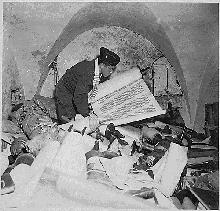
As the US Army drove German troops out of North Africa, Italy, France, Belgium and the Netherlands, Jewish chaplains were uncertain whether any Jews had survived Nazi occupation. To their joy and pain, Jews came out of hiding wherever the military rabbis appeared, telling their sad tales of loss. The Jewish chaplains reclaimed Jewish children from convents, cleansed and restored desecrated synagogues and tried to rebuild broken Jewish communities.
I went to the Army paint shop, gave them my helmet and asked them to paint the Jewish chaplain’s insignia -the two tablets with the Ten Commandments with the Star of David on top of them. With an American Yiddish newspaper in my hand, I repaired to the square of the city. … Within half an hour I had all the [surviving] Jewish families around me. The scene was most moving. … One woman shouted almost hysterically, ‘I am Jewish! I am Jewish!’
Chaplain Isaac Klein
Photographs: NARA

Chaplain Herschel Schachter Leads a Shavuot Service at Buchenwald, May 18, 1945 Even after liberation of the concentration camps, some Jewish Displaced Persons (DPs) remained in them for months, still behind barbed wire fences, until the American military government in Germany established separate camps for Jewish DPs.
The Army and the DPs
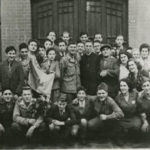
Initially, American military policy defined the stateless Jews in conquered Germany as “enemy nationals.” Regulations prohibited the chaplains from “fraternizing” with the survivors. Compelled by the Jewish survivors’ obvious suffering, the chaplains took two actions: fight to have the regulation changed; and help the DP despite risking a court martial. Eventually, the chaplains’ advocacy helped the military view the Jewish DPs in a more favorable light.
Harrison and his ilk believe that the Displaced Person
is a human being, which he is not, and this applies
particularly to the Jews[,] who are lower than animals.
General George S. Patton to his diary
Photos: NJWB, American Jewish Historical Society
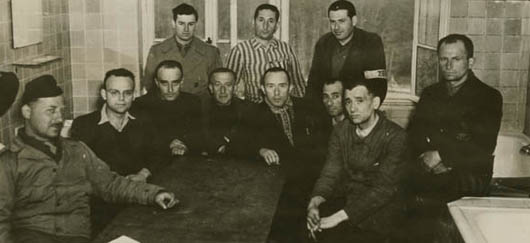
Life in the DP Camps

Life in the DP Camps The chaplains worked day and night to deliver material and spiritual sustenance to the Displaced Persons living in camps operated by the United States Army in Germany. From obtaining kosher food to encouraging political organization to conducting weddings and britim milah, the chaplains helped “rekindle the flame” of Jewish life in the camps.
The problem of morale increases daily [in the DP camps]. The longer the Jew is compelled to be imprisoned in endless waiting, the more difficult will be the problem [of] designing his life to fit the pattern of normal living.
Chaplain Abraham Klausner, August 1945
Photo, top: USHMM, Courtesy Mayer and Rachel Abramowitz
Photo, bottom: USHMM, Courtesy Dr. David Dalin
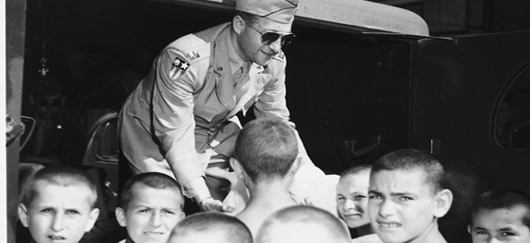
Free to Practice Judaism
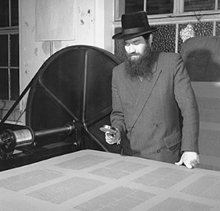
While they were supposedly limited to serving US soldiers, the Jewish chaplains did much to restore the practice of Judaism among the DPs. Chaplain Abraham Klausner arranged for publication of the Survivors’ Haggadah for Passover, 1946, in Munich. The chaplains started Hebrew schools, cleansed and re-opened synagogues and served as rabbis to the survivors. The Seder was the first public celebration of Passover in Berlin since 1932.
Everyone had gathered to celebrate the festival of freedom in Berlin, once the capital of world tyranny. It was a wonderful twist of history. Well, the Seder is over, but, as one speaker put it, the lights of freedom are now on again in Berlin, and for good… As Chaplain (Lt. Col.) O’Reilly, a Catholic priest, senior American chaplain of Berlin, said, “This Passover in Berlin marks a new period for men of all faiths and all lands. So be the will of the Lord.”
Chaplain Herbert Friedman
Photo, top: NARA. Photo, bottom: USHMM, Courtesy of Rae Lifschitz
Synagogue at Foehrenwald DP Camp, 1945
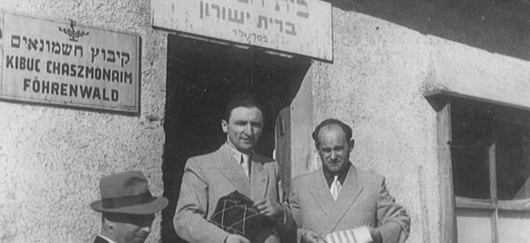
The Chaplains and Zionism
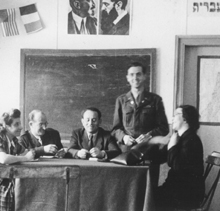
At the start of the war, not all the chaplains were strong Zionists. By its end, almost to a man they believed that only a Jewish homeland in Palestine could guarantee the Jewish people’s survival. The DPs own commitment to Zionism moved the chaplains to become active advocates for the creation of a Jewish state in British-controlled Palestine.
The doors of Palestine must be opened W-I-D-E, not stand just slightly ajar. The plight of these people is deplorable. I recognize that many difficulties stand in the way but … not
much [is being found] in the way of final solutions – and these people are still suffering physically and mentally.
Chaplain David Max Eichhorn
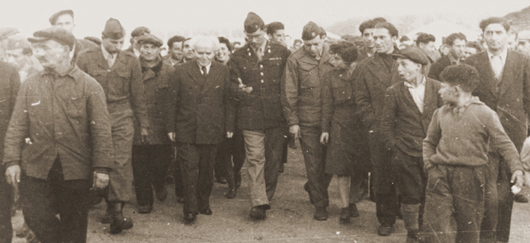
David Ben-Gurion visits Babenhausen DP Camp in 1946; he is escorted by Chaplain Herbert Friedman.
Let My People Go
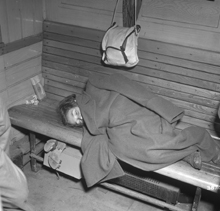
Between 1945 and 1948, the British controlled Palestine and tried to limit Jewish immigration into the territory. Foreseeing no future in Europe, Jewish DPs in the American Zone determined to leave for Palestine despite dangers and the British resistance to their arrival. American Jewish chaplains assisted the DP’s to leave the camps and make clandestine trips to Palestine. A few chaplains eventually made aliyah themselves, living out their Zionist beliefs.
In 1947 the Exodus loaded … near Marseilles. I helped bring 5,000 people to that ship [in] a convoy from the American Zone of Germany across France – 100 trucks with 5,000 people. You can imagine how many armored cars we had
fore and aft. We got 4,400 onto the ship and off she went.
Chaplain Herbert Friedman
Photo, top: NARA. Photo, bottom: Courtesy Hadassah, the Women’s Zionist Organization of America, Inc.
The Exodus 1947. Denied entry to Palestine by the British, passengers were deported back to France, where they refused to disembark.


